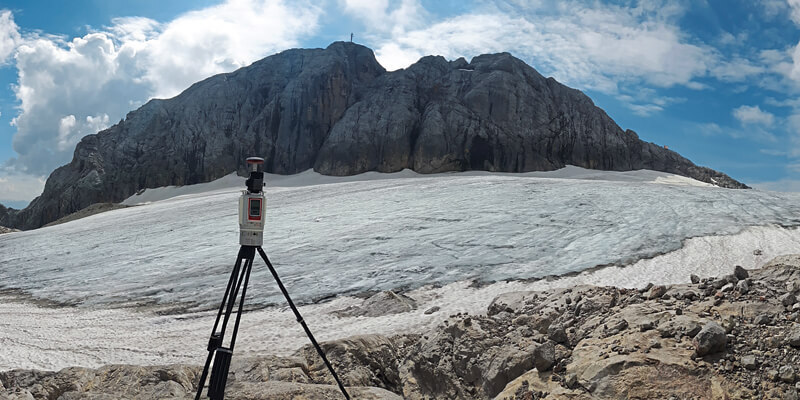A project at the University of Bayreuth is using laser scanners to support rockfall detection in the Alps, as glaciers retreat

In alpine areas, the effects of climate change, which lead to melting of glaciers and thawing of rock permafrost, become clearly visible. Glacier retreat results in rock faces being exposed to atmospheric processes such as solar radiation, warming or freezing.
In the case of freezing processes, ice may form in the rock which develops internal pressure that may lead to the disintegration of the rock, and cause pieces of rock to detach from the wall. This process is also described as frost weathering. In addition, the rock faces are losing their supporting buttresses at the base of the wall due to the glacier melt. Within rock walls, permafrost thaw also causes destabilisation, as rock permafrost connects rock together like concrete. These processes or their combination lead to rockfall events, a hazard not to be underestimated by hikers or also for infrastructures such as cable cars.
Dr Daniel Draebing, the chair of geomorphology of the Faculty of Biology, Chemistry and Earth Sciences at the University of Bayreuth in Germany, has been working on the problem of rockfall detection in the Alps for quite some time.
“At the University of Bayreuth, we use laser scanning to measure hard-to-reach rock faces in the Alps and create high-resolution digital surface models. We repeat these measurements annually and can thus detect changes at the surface, which in our case are caused by rockfall. We have been using a RIEGL VZ-400 for this purpose since 2016, which has provided reliable service all these years. Since June 2019, we have also been working with a RIEGL VZ-2000i, which inspires us with its new, improved technology and the resulting operating advantages, as well as its increased range,” says Dr Draebing.
Among others, they are working on a project entitled “Predicting the effects of climate change on alpine rock slopes: Evaluation of paraglacial and periglacial drivers of rockfall in the European Alps”. Funded by the German Research Foundation, the project investigates the influence of glacier retreat, permafrost thawing and frost weathering on rockfall activity.
For this purpose, rock faces in the Oetztal valley, Austria, as well as in Valais, Switzerland, were measured annually with the RIEGL VZ-400 and in 2019 with the RIEGL VZ-2000i. “Each wall is scanned from different positions in order to make even small-scale irregularities of the rock visible. The different scans are then used to generate a high-resolution surface model with a point density of less than 10cm,” explains Dr Draebing.
Till Mayer, a PhD student at the University of Bayreuth, has been responsible for processing the project’s laser scan data. He adds: “By repeating the laser scanner measurements annually, we can detect changes at the surface that we interpret as rockfall processes. Using the RiScan PRO software package, we can then quantify the volumes of rockfall events and relate them to glacier and permafrost changes and frost weathering events. This allows us to provide meaningful facts and baselines.”
The follow-up project, “Characterising Rockwall Weathering from Microclimate, Rock Moisture and Rockfall Activity — ClimRock”, also funded by the German Research Foundation, investigates rock decay in rock faces through weathering processes such as daily temperature and humidity cycles or daily and seasonal freezing processes. Weathering processes support rockfall events and, similar to the previous project, the researchers want to quantify rock wall erosion and relate it to measured weathering processes.
Mountain faces in the Dachstein massif, Austria, and the Dammkar, part of the German Karwendel mountain range, were selected for the project and measured with the RIEGL VZ-2000i 3D laser scanner. From the highly informative measurement data of the point cloud, the rock face erosion at the individual walls could be quantified and related to measured weathering processes.
“With our research we try to contribute to the study of climate change induced environmental change in the European Alps. We want to understand how glacier retreat, permafrost thawing and weathering processes have determined the appearance of the rock faces and their role in the past, but also on future development of the Alps,” Dr Draebing summarises.


